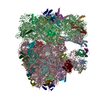+Search query
-Structure paper
| Title | Structurally heterogeneous ribosomes cooperate in protein synthesis in bacterial cells. |
|---|---|
| Journal, issue, pages | Nat Commun, Vol. 16, Issue 1, Page 2751, Year 2025 |
| Publish date | Mar 20, 2025 |
 Authors Authors | Karla Helena-Bueno / Sophie Kopetschke / Sebastian Filbeck / Lewis I Chan / Sonia Birsan / Arnaud Baslé / Maisie Hudson / Stefan Pfeffer / Chris H Hill / Sergey V Melnikov /   |
| PubMed Abstract | Ribosome heterogeneity is a paradigm in biology, pertaining to the existence of structurally distinct populations of ribosomes within a single organism or cell. This concept suggests that ...Ribosome heterogeneity is a paradigm in biology, pertaining to the existence of structurally distinct populations of ribosomes within a single organism or cell. This concept suggests that structurally distinct pools of ribosomes have different functional properties and may be used to translate specific mRNAs. However, it is unknown to what extent structural heterogeneity reflects genuine functional specialization rather than stochastic variations in ribosome assembly. Here, we address this question by combining cryo-electron microscopy and tomography to observe individual structurally heterogeneous ribosomes in bacterial cells. We show that 70% of ribosomes in Psychrobacter urativorans contain a second copy of the ribosomal protein bS20 at a previously unknown binding site on the large ribosomal subunit. We then determine that this second bS20 copy appears to be functionally neutral. This demonstrates that ribosome heterogeneity does not necessarily lead to functional specialization, even when it involves significant variations such as the presence or absence of a ribosomal protein. Instead, we show that heterogeneous ribosomes can cooperate in general protein synthesis rather than specialize in translating discrete populations of mRNA. |
 External links External links |  Nat Commun / Nat Commun /  PubMed:40113756 / PubMed:40113756 /  PubMed Central PubMed Central |
| Methods | EM (single particle) / EM (subtomogram averaging) / EM (tomography) |
| Resolution | 3.2 - 8.2 Å |
| Structure data | EMDB-52036, PDB-9hc4:  EMDB-52351: subtomogram average of the P. urativorans 70S ribosome  EMDB-52352: subtomogram average of the P. urativorans 70S ribosome with one copy of bS20  EMDB-52354: subtomogram average of the P. urativorans 70S ribosome with two copies of bS20  EMDB-52842: Cryo-ET of cryo-FIB milled P. urativorans grown at physiological conditions |
| Source |
|
 Keywords Keywords | RIBOSOME / ribosome heterogeneity / functionally specialized ribosomes / polysome |
 Movie
Movie Controller
Controller Structure viewers
Structure viewers About Yorodumi Papers
About Yorodumi Papers





 psychrobacter urativorans (bacteria)
psychrobacter urativorans (bacteria)